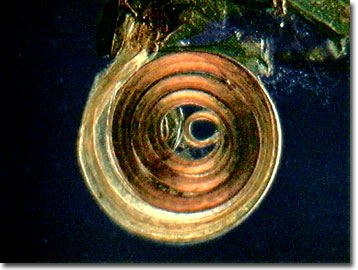Darkfield Digital Image Gallery
Butterfly Proboscis
A tubular sucking organ, the proboscis enables a butterfly to extract sweet nectar from the flowers it feeds upon, regardless of the shape of the blossom. When not being used, a butterfly's proboscis is rolled up out of the way.

Unlike caterpillars (larval butterflies), adult butterflies do not possess any chewing mouthparts, and therefore, must obtain their nutrition for reproduction and flight from sipping liquids. Hydrostatic pressure extends the curled proboscis into a relatively straight "straw", which is inserted deep into the tubes of flowers. Some tropical species such as the Morphos and owl butterflies, which typically live in the rainforest understory, do not have a constant supply of flower nectar and must resort to feeding on the liquids of fermenting fruits. Butterflies must also obtain moisture and salts through their proboscises. Puddling, a behavior commonly exhibited by male butterflies, describes the sipping of moisture from puddles, wet sands and soil, and even moist manure. It is believed by lepidopterists and insect physiologists that the salts dissolved in these liquids help increase the fertility of the male butterflies.
At emergence from the chrysalis, the proboscis is initially formed in two parts, appearing similar to a forked tongue. Almost immediately, two palpi, one on each side of the proboscis, begin working on the dual structure, forming it into a single tube, sometimes 1.5 times the length of the butterfly's body. A few species of butterfly use their proboscises to feed on rotting animal flesh or animal fluids. The harvester butterfly pierces the bodies of wooly aphids with its sharp proboscis and drinks the body fluids, while the Asian vampire moth actually pierces the skin of its animal prey with a strong, sharp proboscis and drinks the blood. Moths have similar tube-like, flexible "tongues". The hawk or Sphinx moths (adults of the hornworms), sometimes mistaken for hummingbirds, are the lepidopterans with the longest proboscises, with lengths up to 35 centimeters (14 inches) reported. Other ephemeral species, such as the luna moth, do not have a proboscis since their lifespan as an adult is very short and they do not feed.
Some species of flowering plant that naturally provide a good source of nutritious nectar for butterflies may not do so when bred and cultivated for other traits. This limitation is common in marigolds with double or triple blooms that physically prevent probing by the insect's tubular organ. Other plants have eye-catching beauty or long-lasting flowers, but do not produce the quality and quantity of nectar available in the wild cultivars. Interestingly, butterflies actually taste using sensors located in their feet, not their proboscises, and therefore can evaluate the quality of a flower or fruit by landing on it, before unfurling their long siphons for a nutritious sip.
Contributing Authors
Cynthia D. Kelly, Thomas J. Fellers and Michael W. Davidson - National High Magnetic Field Laboratory, 1800 East Paul Dirac Dr., The Florida State University, Tallahassee, Florida, 32310.
BACK TO THE DARKFIELD IMAGE GALLERY
BACK TO THE DIGITAL IMAGE GALLERIES
Questions or comments? Send us an email.
© 1995-2025 by Michael W. Davidson and The Florida State University. All Rights Reserved. No images, graphics, software, scripts, or applets may be reproduced or used in any manner without permission from the copyright holders. Use of this website means you agree to all of the Legal Terms and Conditions set forth by the owners.
This website is maintained by our
Graphics & Web Programming Team
in collaboration with Optical Microscopy at the
National High Magnetic Field Laboratory.
Last Modification Friday, Nov 13, 2015 at 01:19 PM
Access Count Since September 17, 2002: 31837
Visit the website of our partner in introductory microscopy education:
|
|
